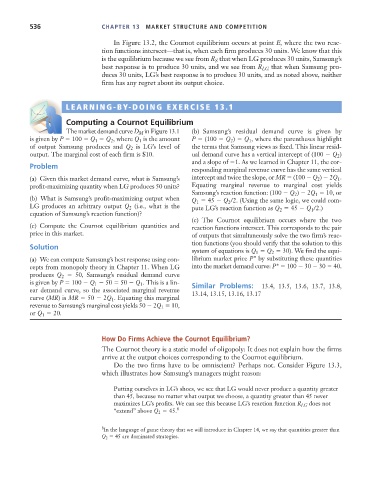Page 562 - Microeconomics, Fourth Edition
P. 562
c13marketstructureandcompetition.qxd 7/30/10 10:44 AM Page 536
536 CHAPTER 13 MARKET STRUCTURE AND COMPETITION
In Figure 13.2, the Cournot equilibrium occurs at point E, where the two reac-
tion functions intersect—that is, when each firm produces 30 units. We know that this
is the equilibrium because we see from R that when LG produces 30 units, Samsung’s
S
best response is to produce 30 units, and we see from R LG that when Samsung pro-
duces 30 units, LG’s best response is to produce 30 units, and as noted above, neither
firm has any regret about its output choice.
LEARNING-BY-DOING EXERCISE 13.1
S
E D
Computing a Cournot Equilibrium
The market demand curve D M in Figure 13.1 (b) Samsung’s residual demand curve is given by
is given by P 100 Q 1 Q 2 , where Q 1 is the amount P (100 Q 2 ) Q 1 , where the parentheses highlight
of output Samsung produces and Q 2 is LG’s level of the terms that Samsung views as fixed. This linear resid-
output. The marginal cost of each firm is $10. ual demand curve has a vertical intercept of (100 Q 2 )
and a slope of 1. As we learned in Chapter 11, the cor-
Problem
responding marginal revenue curve has the same vertical
(a) Given this market demand curve, what is Samsung’s intercept and twice the slope, or MR (100 Q 2 ) 2Q 1 .
profit-maximizing quantity when LG produces 50 units? Equating marginal revenue to marginal cost yields
Samsung’s reaction function: (100 Q 2 ) 2Q 1 10, or
(b) What is Samsung’s profit-maximizing output when Q 1 45 Q 2 /2. (Using the same logic, we could com-
LG produces an arbitrary output Q 2 (i.e., what is the pute LG’s reaction function as Q 2 45 Q 1 /2.)
equation of Samsung’s reaction function)?
(c) The Cournot equilibrium occurs where the two
(c) Compute the Cournot equilibrium quantities and reaction functions intersect. This corresponds to the pair
price in this market. of outputs that simultaneously solve the two firm’s reac-
tion functions (you should verify that the solution to this
Solution
system of equations is Q 1 Q 2 30). We find the equi-
(a) We can compute Samsung’s best response using con- librium market price P* by substituting these quantities
cepts from monopoly theory in Chapter 11. When LG into the market demand curve: P* 100 30 30 40.
produces Q 2 50, Samsung’s residual demand curve
is given by P 100 Q 1 50 50 Q 1 . This is a lin- Similar Problems: 13.4, 13.5, 13.6, 13.7, 13.8,
ear demand curve, so the associated marginal revenue 13.14, 13.15, 13.16, 13.17
curve (MR) is MR 50 2Q 1 . Equating this marginal
revenue to Samsung’s marginal cost yields 50 2Q 1 10,
or Q 1 20.
How Do Firms Achieve the Cournot Equilibrium?
The Cournot theory is a static model of oligopoly: It does not explain how the firms
arrive at the output choices corresponding to the Cournot equilibrium.
Do the two firms have to be omniscient? Perhaps not. Consider Figure 13.3,
which illustrates how Samsung’s managers might reason:
Putting ourselves in LG’s shoes, we see that LG would never produce a quantity greater
than 45, because no matter what output we choose, a quantity greater than 45 never
maximizes LG’s profits. We can see this because LG’s reaction function R LG does not
“extend” above Q 2 45. 8
8 In the language of game theory that we will introduce in Chapter 14, we say that quantities greater than
Q 2 45 are dominated strategies.

